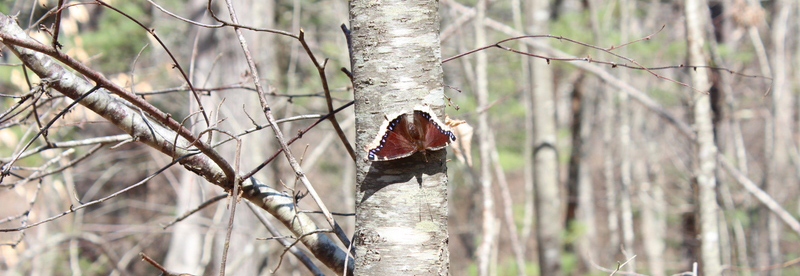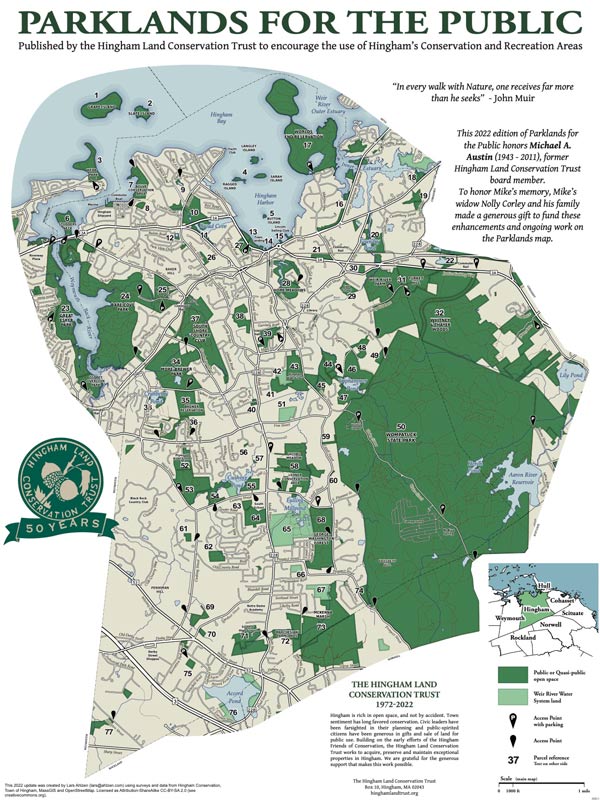 Our curious crowd enjoyed a two hour walk with guide Steve Ivas while exploring the expansive beauty of Wheelwright Park in Cohasset. Blue skies and warm sun welcomed us and brought out some local denizens: a garter snake, turtles, and the first butterfly of the season.
Our curious crowd enjoyed a two hour walk with guide Steve Ivas while exploring the expansive beauty of Wheelwright Park in Cohasset. Blue skies and warm sun welcomed us and brought out some local denizens: a garter snake, turtles, and the first butterfly of the season.
An escarpment forms a long, straight cliff (photo), giving the park its divided water shed. This is a unique geological feature, where land separates along a fault line. With comradery, humor, and shared knowledge, an enjoyable time was had by all.
More detailed 2017 Wheelwright Walk Notes
(courtesy of HLCT Board Member Don Kidston)
On a beautiful spring day, HLCT President Skip Hull welcomed the guests and introduced guide Steve Ivas. The group consisted of 21 people including 4 HLCT trustees and Steve. Steve described the park layout and noted that the abundance of granite in the area was an extension of granite from the Blue Hills.
As we started down the trail the group was greeted by a garter snake slithering by.
Steve described Devil’s Chair rock as being formed by ice with the expansion of melting ice in cracks in the rock causing the Rock to break. Devil’s chair is a large glacial erratic with what appears to be a chair seat cut unto the rock.
Steve noted that a standing dead tree is call a snag and asked what a lying dead tree is —- a log. At Little Tippling, another glacial erratic, Steve pointed out rock tripe growing on the south side of the rock. Rock tripe is an edible lichen moss that was eaten by George Washington’s troops camped by the Potomac in December of 1777.
As we walked along Wheelwright Park Lane Steve pointed out various vegetation including wetlands plants (wintergreen), edibles (blueberries), Tupelo, as a tree that has no value for lumber and grows in clusters near streams, and beach. He also pointed out an intermittent stream that flows towards Cohassett’s Little Harbor. Steve noted that Wheelwright Park Lane, on which we walked, was built by the WPA in the 1930s. As we entered Cornelia and Richardson White Woods Steve pointed out cedar trees and poison ivy.
Arriving at the Ice Pond in Holly Hill Farms, Steve noted that ice was harvested from the farm from the 1860s into the 1940’s. The ice was stored in sawdust and used in the local area during the summer. The back-drop for the ice pond is a beautiful escarpment, or long cliff, created by a rising rock wall and/or settlement of the adjacent land along a geological fault. Steve pointed out that the vegetation on the wall demonstrates an evolution in plant growth. On a log at the edge of the pond the group observed painted turtles sunning themselves.
The walk continued along the face of the long escarpment back towards the White Woods. Along the way, Steve pointed out more plants including: red maples, sassafras, high-bush blueberry, red and white pine, and spice bush. At a trail juncture, we stopped to observe the spring that formed the headwaters for the stream that fed the ice pond. At a vernal pool near the top of a hill we observed a vernal pool. On the east side of the hill Steve noted that wood frogs and spring peepers could be found downhill in a vernal pool off of a side trail. The group observed a strikingly bright red mushroom growing on animal scat.
Back on Wheelwright Park Lane Steve pointed out turkey tails, a multicolored fungus, growing on a beach tree that had been cut down and was lying by the road-side. Near the Boy Scout Campground, we stopped to observe big tippling, a huge glacial erratic. Continuing through the Boy Scout Campground into Barnes Wildlife Sanctuary we crossed a stream downgrade from an area of wetlands. Steve pointed out that the stream flows through the parkland across Jerusalem Road into the ocean.
As we continued through the Barnes Sanctuary Steve pointed out a rock fern, which grows directly on rock. Steve also pointed out coal along the trail which might have dated from the days of WPA construction in the area. The group also saw the first butterfly of spring.
As the group reentered Wheelwright Park we stopped to observe the Barnes Sanctuary dedication plaque fixed to the side of a large rock. Steve pointed out a cluster of Beech trees and noted that they have allopathic roots which prevent growth of competing plants. As we passed the skating pond, which was built in 1935 by the WPA, it was noted that the low water levels had been attributed to disturbing of the bottom clay seal of the pond, during a Boy Scouts project in 2002, permitting water to infiltrate the underlying soils. The group stopped to observe Split Rock, a large glacial erratic. Steve described, that as with Devil’s Chair, the rock was split by ice forming in cracks in the rock and thawing.
On the walk back to the parking lot Steve pointed out more invasive plants including ivy, burning bush and vinca. Steve was thanked for his excellent job of leading the walk and arranging for beautiful spring weather for the outing.

























